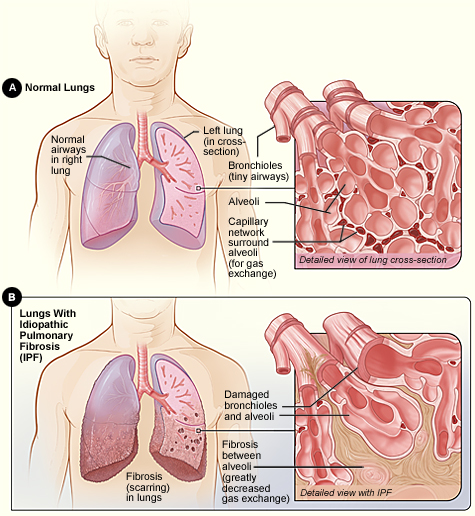Pulmonary Fibrosis (PF) is a debilitating disease, marked by progressive scarring of the lungs, that increasingly hinders a person’s ability to breathe.

Sometimes pulmonary fibrosis can be linked to a particular cause, such as environmental exposure, chemotherapy or radiation therapy, infection, or autoimmune diseases such as rheumatoid arthritis. However sometimes there is no known cause and is referred to as idiopathic pulmonary fibrosis or IPF.
The cause of Pulmonary Fibrosis still remains a mystery, but it is seems to involve changes in the lung’s normal healing processes. Patients may have an exaggerated or uncontrolled healing response that over time produces excessive fibrous scar tissue, or fibrosis, in the lungs. This scarring causes the lung’s tiny alveoli to thicken and harden, rendering them less able to function and provide the body with the oxygen it needs.
There are a few risk factors that may alter the lung’s healing process and cause scarring. These may include:
- Cigarette smoking
- Occupational exposure to dusty environments (e.g. wood or metal dust)
- Genetic predisposition (10-15 percent of cases)
- Viral or bacterial lung infections
- Acid reflux disease
Pulmonary Fibrosis hinders a person’s ability to take in oxygen. It causes shortness of breath and is usually associated with a persistent dry cough. The disease progresses over time, leading to an increase in lung scarring and a worsening of symptoms. Unfortunately, Pulmonary Fibrosis is ultimately disabling and fatal.
If you have been diagnosed with Pulmonary Fibrosis, there are a number of things you can do to take part in your own treatment and help yourself stay healthy.
- Get your flu vaccine every year.
- Stop smoking.
- Consult your doctor about enrolling in a pulmonary rehabilitation or respiratory therapy program to help increase your strength, learn breathing techniques, and expand your social support network. Many patients report improved breathing and quality of life after adding education and exercise to their treatment.
- Eat a well-balanced diet to maintain in ideal body weight. This helps support your body and keeps up your strength.
- Consider eating smaller, more frequent meals during the course of your day. Many patients find it easier to breathe when their stomach isn’t completely full.
When Pulmonary Fibrosis progresses to a point where your blood-oxygen levels are low, another important tool that can help sufferers is supplemental oxygen therapy. Oxygen can be prescribed by your doctor or via a local oxygen supply company. It contains a higher percentage of oxygen and helps increase the amount of oxygen that is available to be transferred from your lungs into the bloodstream, thereby producing more energy to be used by the cells of your body.
Supplemental oxygen can:
- Decrease your shortness of breath – especially with exercise
- Improve your ability to perform daily activities
- Improve your overall level of fitness
- Improve your quality of life
- Increase life span by decreasing the extra work your heart is doing because of low oxygen saturation levels
And in case you need medical oxygen at any destination worldwide please contact us on info@oxygenworldwide.com and we will try to meet your specific requirements.




